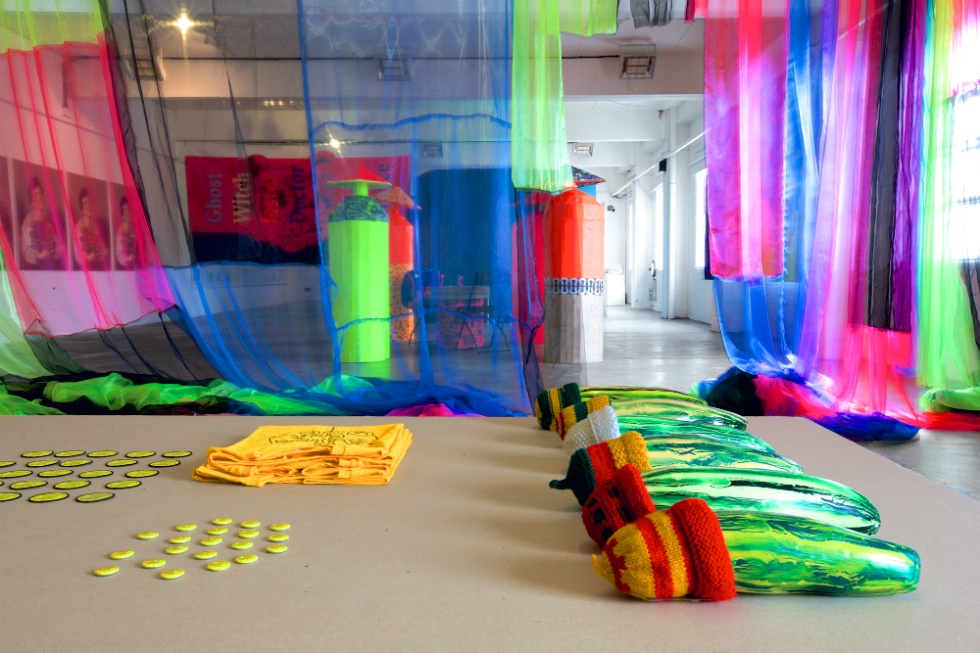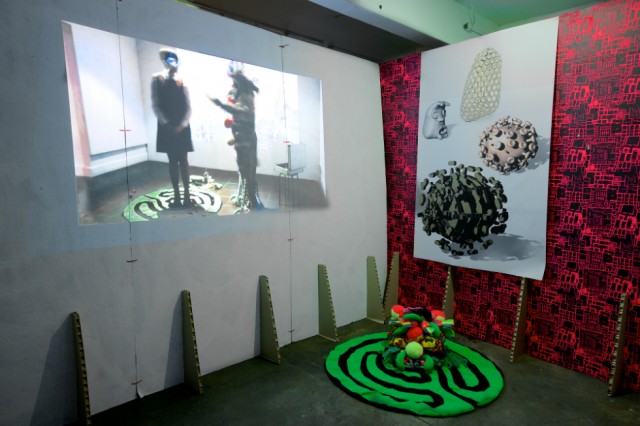“The fight against HIV/AIDS is not over”: The Seductive World Of Alien Sex Club

Awkwardness, arts activism, and the HIV virus as a “clever trickster”: David Graham discusses this and more with the artist behind Homotopia festival’s focus exhibition…
The global pandemic of HIV and AIDS takes centre stage in John Walter’s visually arresting, in your face artwork Alien Sex Club. Shown at Ambika P3 in London earlier this year, Walter’s vibrant work — which takes the shape of a ‘cruise maze’, a spatial form common to sex clubs and gay saunas – is currently at Liverpool’s Homotopia festival: the only lesbian, gay, bisexual and trans combined arts organisation in the North of England.
However, this headlining exhibition is by no means exclusively for or about an LGBT audience. Walter is adamant that his work is not solely aimed at this community; statistics show that gay men remain one of the groups most at risk of HIV in the UK, yet heterosexual people accounted for 45% of new diagnoses in 2012.
Meeting Walter, one realises that he is his work personified. Aesthetically, he is the human equivalent of a dazzle ship, wearing a different, brightly patterned shirt saturated in colour at each of our interviews. His densely layered creative vision has been formed from collaborations with Dr Alison Rodger, senior lecturer and honorary consultant in infectious diseases at University College London; filtering out confusing medical terminology in order to make the work accessible and palatable to an audience old and young. Walter professes to be an “artist activist” and an “image breeder”; his work is a reminder or a wake-up call for everyone that thought HIV and AIDS were part of the past.
Alien Sex Club has taken shape at a triad of different locations in Liverpool: soft sculpture the Walker Art Gallery, discussion and alternative tarot readings at The Bluecoat, and a large focus exhibition at Camp and Furnace.
Walter describes each location as an “entry point”; the “safest” of which is the Walker. In true Walter fashion, Pug Virus — a vibrant pink, imposing inflatable fabrication — jolts the senses as one ascends the gallery’s grand staircase. The placement of this benign, friendly blancmange-like structure is skilfully juxtaposed with the neighbouring Victorian paintings on display. Pug Virus is the perfect precursor to Alien Sex Club as it sets the tone for the more exuberant elements of the exhibition; or as Walter notes, “it sets the brain on a weird trajectory.”

Walter admits to walking a sensitive tightrope with his choice of subject matter; he plays with the viewer through his work but by no means trivialises the fundamental complexities of sexual health. His knowledge, credibility and “respect for the virus as a clever trickster” is reflected in the esteemed support he has received from health professionals and collaborators as well as funding from The Wellcome Trust. Walter’s artistic relationship with HIV/AIDS in the form of Alien Sex Club is more than a casual fling; it is a manifestation of a long-term, meaningful engagement with theoretical and empirical research for his PhD.
Walter’s exhibition at Camp and Furnace is by no means conventional but more of a sensory experiential event. One is greeted by friendly invigilators who reassuringly explain the narrative and journey that you are about to embark on; befriended by and temporarily becoming the custodian of a well-dressed marrow, you enter through an ‘immunity curtain’ before descending into a multi-sensory labyrinthine structure. Walter rejects minimalist subtlety for a maximalist assault on the senses; the traditional gallery space is replaced by, Walter says, a “clubby, grubby” atmospheric gay maze, contextualising the significance and growth of HIV/AIDS amongst this demographic.
Walter by no means superficially touches on this theme, but unashamedly and unapologetically confronts the transmission of the virus in order to bring the on-going issues of HIV/AIDS to the forefront of our consciousness. The slightly abstract, somewhat peripheral advertising campaigns of the 1990s are in complete contrast to Walter’s strategy and USP – disseminating a serious message through play, fun and colour.
Less is more is not part of Walter’s artistic vocabulary. He goes in with a fully-loaded visual canon, ready to eradicate myths and misconceptions, and resulting in a sensory overload of neon, audio, digital and printed works, colour and performance. His determination to avoid preaching is achieved through a stimulating range of work; as a result, Alien Sex Club deserves multiple visits to fully appreciate and comprehend the evolution and threats that HIV and AIDS pose as well as the promising advances in medical technology.

Walter has a reputation for producing seductive worlds that, in his words, “cause awkwardness”. This was evident on the opening night, as a diverse group of hesitantly giddy visitors descended into the neon lit depths of the ‘alien’ space; reinforcing, one hopes, Walter’s ethnographic aims for the work and his on-going research.
Although Alien Sex Club will close its doors at the end of November, the resulting discourse will inevitably and unfortunately continue as the fight against HIV/AIDS is not over. The legacy of Walter’s magnum opus is already tangible. Free HIV tests have been available during the exhibition; a welcome and important service accessible outside of the confines of conventionally daunting medical environments.
Alien Sex Club is an ambitious project whose future is unknown beyond Homotopia. Walter describes it as a “kit”, but queries whether it could become a HIV Roadshow in its current state and scale. Once prompted, the artist considered the effectiveness and logistics of separating his work into smaller “pods” or “capsids” in order to roll it out to a wider, receptive audience, thus extending its potential and longevity.
Historically, Homotopia festival has successfully launched an educational aspect to their portfolio in the shape of Project Triangle: developing hate crime awareness and homophobic bullying resources. Although Walter will be working with local health organisations — such as Sahir House and The Armistead Centre — whilst the exhibition is open, there are no plans for Homotopia to engage with schools focusing on sexual health using Walter’s work as catalyst point.

Although censorship is advised in parts for a younger audience, in my capacity as an artist teacher in secondary education it is disappointing that Homotopia has not linked the mandatory Physical, Social, Health Education (PSHE) requirement of the curriculum to their education programme. The demand and need certainly exists.
The headline-grabbing and alarming slogan Silence = Death was commonplace in the early years of HIV/AIDS, instigated by activists and disseminated via the media. Now, Homotopia’s optimistic mission statement, ART = LIFE, injects vitality into the arts. With Alien Sex Club in mind, perhaps this simple equation should be refined to Art + Education = Life?
Nonetheless, John Walter’s Alien Sex Club is a highlight of Homotopia’s thought-provoking offer. Just as the festival has evolved over the past 12 ground-breaking years, Walter’s work celebrates the huge steps that have been achieved to secure a healthier and safer future.
David Graham
This article has been commissioned for the collaborative #BeACritic project — an annual programme of mentoring and commissioned critical articles for North-West-based writers, initiated and supported by The Double Negative, Liverpool John Moores University and Arts Council England. See more here
See Alien Sex Club at Camp and Furnace, Liverpool, until 29 November 2015 — FREE
See Homotopia festival at venues across Liverpool until 1 December 2015 — ticket prices vary
All images courtesy Rob Battersby, with thanks





